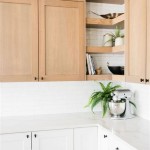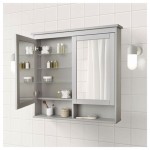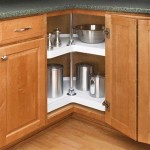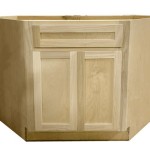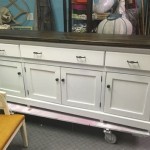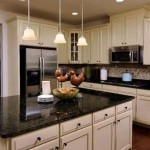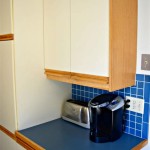How to Paint Wood Kitchen Cabinets White
Painting wood kitchen cabinets white is a popular and effective way to revitalize a kitchen's aesthetic. It brightens the space, creates a clean and modern feel, and can significantly increase the value of a home. While the process requires time and attention to detail, it is a manageable DIY project that can transform the heart of the home. This article details the necessary steps, materials, and techniques required to achieve a professional-looking white finish on wood kitchen cabinets.
Before embarking on this project, it's crucial to understand the importance of proper preparation. Rushing through the initial steps can lead to an uneven finish, poor adhesion, and ultimately, a less-than-desirable outcome. Taking the time to meticulously clean, sand, and prime the cabinets will ensure a durable and beautiful painted surface.
Key Point 1: Preparing the Cabinets for Painting
The foundation of a successful cabinet painting project lies in thorough preparation. This involves cleaning, removing hardware, sanding, and dealing with any existing imperfections.
Cleaning: Begin by removing all items from inside the cabinets. Use a degreasing cleaner specifically designed for kitchen surfaces to remove grease, grime, and food residue. A mixture of warm water and dish soap can also be effective. Pay particular attention to areas around the stove and sink, as these tend to accumulate the most buildup. Rinse the surfaces thoroughly with clean water and allow them to dry completely before proceeding. A tack cloth can be used to ensure all dust and residue are removed.
Hardware Removal: Remove all cabinet doors and drawers. Label each door and drawer with a piece of painter's tape and a corresponding number on the cabinet frame to ensure they are reinstalled in the correct location. Remove all hardware, including knobs, pulls, hinges, and any other decorative elements. Store the hardware in a safe place to prevent loss or damage. Consider replacing the hardware with new pieces to further update the look of the kitchen. If reusing the existing hardware, thoroughly clean and polish it.
Sanding: Sanding is a critical step in preparing the cabinets for paint. It creates a slightly textured surface that allows the primer and paint to adhere properly. Use a medium-grit sandpaper (120-150 grit) to sand all surfaces of the cabinet doors, drawer fronts, and frames. Focus on removing any existing gloss or imperfections. For intricate areas, sanding sponges or detail sanders can be helpful. After sanding, use a fine-grit sandpaper (220 grit) to smooth out any rough spots. Wipe down all surfaces with a tack cloth to remove sanding dust. The goal is not to remove the existing finish entirely, but rather to create a profile for better adhesion.
Addressing Imperfections: Inspect the cabinets for any dings, scratches, or cracks. Use wood filler to fill in these imperfections. Allow the wood filler to dry completely according to the manufacturer's instructions. Once dry, sand the filled areas smooth with fine-grit sandpaper, blending them seamlessly with the surrounding surface. Overfilling the imperfections initially will make sanding down to a smooth surface easier. Ensure the wood filler is completely flush with the surrounding wood.
Masking: Protect surrounding surfaces, such as countertops, walls, and flooring, with painter's tape and drop cloths. Mask off any areas of the cabinets that you do not want to be painted, such as the inside edges of the cabinet frames. A sharp utility knife can be used to create clean, precise lines with the painter's tape. Ensure all edges are firmly pressed down to prevent paint bleed.
Key Point 2: Priming and Painting the Cabinets
After meticulous preparation, the next stage involves applying a high-quality primer and paint to achieve a durable and attractive finish.
Choosing the Right Primer: Primer is essential for creating a smooth and uniform surface for the paint to adhere to. It also helps to block stains and prevent the existing wood finish from bleeding through the paint. Select a high-quality oil-based or acrylic-latex primer specifically designed for cabinets. Oil-based primers provide excellent adhesion and stain blocking, but they require more cleanup and have a stronger odor. Acrylic-latex primers are water-based, easier to clean up, and have lower VOCs (volatile organic compounds). Consider using a stain-blocking primer if you have stained cabinets, or cabinets made from wood that bleeds tannins. Tinting the primer towards the final paint color can also improve coverage.
Applying the Primer: Apply the primer in thin, even coats using a high-quality brush, roller, or sprayer. For a smooth finish, a foam roller is recommended. Use a brush for hard-to-reach areas and details. Allow the primer to dry completely according to the manufacturer's instructions. Lightly sand the primed surface with fine-grit sandpaper (220 grit) to remove any imperfections or brush marks. Wipe down the surface with a tack cloth to remove sanding dust. A second coat of primer may be necessary for heavily stained or porous wood.
Selecting the Right Paint: Choose a high-quality paint specifically formulated for kitchen cabinets. Acrylic-latex paints are generally recommended for their durability, ease of cleaning, and low VOCs. Opt for a paint with a satin or semi-gloss finish, as these finishes are more resistant to moisture and stains and are easier to clean than matte finishes. Consider the sheen level carefully, as too much gloss can highlight imperfections. The color should be carefully considered in relation to the overall kitchen design and lighting.
Applying the Paint: Apply the paint in thin, even coats using a high-quality brush, roller, or sprayer. As with the primer, a foam roller is recommended for a smooth finish. Use a brush for hard-to-reach areas and details. Allow the paint to dry completely according to the manufacturer's instructions. Lightly sand the painted surface with fine-grit sandpaper (320 grit) to remove any imperfections or brush marks. Wipe down the surface with a tack cloth to remove sanding dust. Apply a second coat of paint for full coverage and durability. Allow the second coat to dry completely before reassembling the cabinets.
Spraying vs. Brushing/Rolling: Using a paint sprayer will generally result in a smoother, more professional-looking finish. However, it requires more setup and cleanup, as well as a well-ventilated space. If using a sprayer, be sure to thin the paint according to the manufacturer's instructions and practice on a scrap piece of wood before painting the cabinets. Brushing and rolling are more accessible for DIYers, but require more technique to avoid brush marks or roller stipple. Use high-quality brushes and rollers, and apply the paint in thin, even coats to minimize these issues.
Key Point 3: Reassembly and Finishing Touches
The final stage involves reassembling the cabinets, reinstalling the hardware, and making any necessary touch-ups to ensure a professional and polished result.
Reassembling the Cabinets: Once the paint is completely dry, carefully reattach the cabinet doors and drawers to the corresponding frames using the previously applied labels. Ensure the hinges are properly aligned and tightened. Adjust the hinges as needed to ensure the doors hang straight and close properly. Minor adjustments to hinge placement may be necessary after painting.
Reinstalling Hardware: Reinstall the hardware, including knobs, pulls, and any other decorative elements. If replacing the hardware, ensure the new hardware is compatible with the existing mounting holes. If necessary, drill new holes for the new hardware, being careful not to damage the painted surface. Consider using a drill guide to ensure accurate hole placement.
Touch-Ups: Inspect the painted surfaces for any imperfections, such as drips, runs, or missed spots. Use a small brush to touch up these areas with the same paint used for the main coats. Allow the touch-up paint to dry completely. For larger imperfections, lightly sand the area with fine-grit sandpaper and apply a thin coat of paint.
Cleaning and Maintenance: Once the cabinets are reassembled and any touch-ups are complete, clean the painted surfaces with a mild soap and water solution. Avoid using harsh chemicals or abrasive cleaners, as these can damage the paint finish. Regularly clean the cabinets to prevent the buildup of grease and grime. A soft cloth or sponge is recommended for cleaning.
Curing Time: Allow the paint to fully cure before using the cabinets extensively. Curing time can vary depending on the type of paint and the environmental conditions. Generally, it is recommended to wait at least a few days, or even a week, before placing heavy items inside the cabinets or subjecting them to excessive wear and tear. This will allow the paint to fully harden and become more resistant to scratches and chipping.
Painting wood kitchen cabinets white is a significant undertaking that requires careful planning and execution. By following these detailed steps, individuals can achieve a professional-looking finish that will transform their kitchen and increase the value of their home. The key to success lies in thorough preparation, the use of high-quality materials, and attention to detail throughout the entire process. This project offers a cost-effective alternative to replacing cabinets and allows homeowners to personalize their kitchen space.

How To Paint Kitchen Cabinets White In 5 Days For 150 The Nutritionist Reviews

Pros And Cons Of Painting Kitchen Cabinets White De Manor Farm By Laura Janning

Painting White Kitchen Cabinets To Look Like Wood Repainting Makeover

How To Paint Fake Wood Kitchen Cabinets Simple Made Pretty 2024

Painting Your Kitchen Cabinets White

How To Paint Kitchen Cabinets The Right Way Created Home

How To Paint Oak Cabinets And Hide The Grain Tutorial

Tips Tricks To Paint Honey Oak Kitchen Cabinets Cottage Living And Style

Painting Kitchen Cabinets With Chalk Paint Simply Today Life

How To Paint Cabinets The Right Way Flooring Girl
Related Posts

